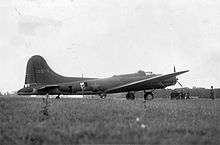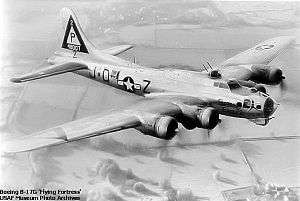RAF Grafton Underwood
| RAF Grafton Underwood USAAF Station 106 .png) | |
|---|---|
| Located Near Kettering, Northamptonshire, England | |
|
Aerial photograph of Grafton Underwood airfield. The bomb dump is to the north of the perimeter track on the west side of the airfield. 22 April 1944. Note the large number of 384th Bomb Group B-17s on hardstands. | |
 RAF Grafton Underwood | |
| Coordinates | 52°25′15″N 000°38′59″W / 52.42083°N 0.64972°W |
| Type | Military airfield |
| Code | GU |
| Site information | |
| Controlled by |
Royal Air Force United States Army Air Forces |
| Site history | |
| Built | 1941 |
| In use | 1941–1959 |
| Battles/wars |
European Theatre of World War II Air Offensive, Europe July 1942 – May 1945 |
| Garrison information | |
| Garrison |
RAF Bomber Command Eighth Air Force |
Royal Air Force Grafton Underwood or more simply RAF Grafton Underwood is a former Royal Air Force station located 4 miles (6.4 km) northeast of Kettering, Northamptonshire, England.
Royal Air Force use
The airfield was opened in 1941 and was first used by the RAF Bomber Command No. 1653 Heavy Conversion Unit RAF with Consolidated Liberators. The original runways were approximately 1,600 yards and 1,100 yards in length. However, these were unsuitable for the operation of heavy, four-engined bombers and the field was upgraded to Class A airfield standards, including the lengthening of the runways to the required 2,000 yards for the main and 1,400 yards for each of the others, started in late 1942.
United States Army Air Forces use
Grafton Underwood was assigned United States Army Air Forces Eighth Air Force in 1942. Its designation was USAAF Station 106.
USAAF Station Units assigned to RAF Grafton Underwood were:[1]
- 443d Sub-Depot
- 18th Weather Squadron
- 33rd Station Complement Squadron
Regular Army Station Units included:
- 1119th Quartermaster Company
- 1140th Military Police Company
- 1774th Ordnance Supply & Maintenance Company
- 854th Chemical Company
- 2023rd Engineer Fire Fighting Platoon
- 203rd Finance Section
15th Bombardment Squadron (Light)

The first United States Army Air Forces Eighth Air Force tenant on Grafton Underwood was the 15th Bombardment Squadron, arriving on 12 May 1942 from Batchelor, Australia. The squadron flew the British Boston III light bomber. The 15th was originally part of the 27th Bombardment Group (Light), based in the Philippine Islands, however the group's planes (A-24's), did not arrive by 7 December 1941. Due to the deteriorating situation in the Philippines after the Japanese attack, they were diverted to Australia where they reformed into a combat unit and fought in the Dutch East Indies and New Guinea Campaigns.
When the 27th Bombardment Group was inactivated and transferred back to the United States for re-equipping, the surviving members of the group were first transferred back to the United States, then to the UK.
At the time Grafton Underwood was lacking many facilities, and the squadron moved to RAF Molesworth in mid June.
97th Bombardment Group (Heavy)

In early July 1942, the 97th Bombardment Group (Heavy) arrived at Grafton Underwood with two Boeing B-17E Flying Fortress bomber squadrons, the 342d and 343d. The ongoing construction at the airfield limited its ability to support a full bomb group, and it acted as a satellite airfield for RAF Polebrook. However, the 97th had already been there in England for some time, because the 340th Squadron was already at Polebrook and had arrived months before the 342nd and 343rd had gotten to Grafton.
The 97th Bomb Group is famous for flying the first Eighth Air Force heavy bomber mission of the war, attacking the Rouen-Sotteville marshalling yards in France. The lead aircraft of the group, Butcher Shop, was piloted by the Group Commander, Colonel Frank A. Armstrong, and squadron commander of the 340th Major Paul W. Tibbets (who later flew the Enola Gay to Hiroshima Japan on the first atomic bomb mission). In the leading aircraft of the second flight, Yankee Doodle, flew General Ira C. Eaker, the commanding general of the Eighth Air Force Bomber Command.
Through the summer, aircraft from the 342d and 343d bomb squadrons joined with the aircraft at Polebrook attacking airfields, marshalling yards, industries, naval installations, and other targets in France and the Low Countries.
In September the 97th Bomb Group left Grafton Underwood and consolidated its aircraft at Polebrook. In October the Group was transferred to the Twelfth Air Force in the Mediterranean theatre and then 15th Air Force and went on to lead a number of secret and daring missions all over Europe.
305th Bombardment Group (Heavy)
The 305th Bombardment Group (Heavy), arrived from Muroc AAF, California during September 1942, replacing the 97th. The Group was assigned to the 40th Combat Wing at RAF Thurleigh. The group tail code was a "Triangle G". Its operational squadrons were:
- 364th Bombardment Squadron (B-17F) (WF)
- 365th Bombardment Squadron (B-17F) (XK)
- 366th Bombardment Squadron (B-17F) (KY)
- 422d Bombardment Squadron (B-17F) (JJ)
At Grafton Underwood, the group began combat on 17 November 1942 and attacked such targets as submarine pens, docks, harbours, shipyards, motor works, and marshaling yards in France, Germany, and the Low Countries.
During December 1942, the group was transferred to RAF Chelveston.
96th Bombardment Group (Heavy)
The next Eighth Air Force heavy bomb group to arrive was the 96th Bombardment Group (Heavy) which flew in from Pyote AAF Texas in the latter part of April 1943.
The 96th Bombardment Group was assigned to the 45th Combat Bombardment Wing of the 3rd Bombardment Division. Its tail code was Square-C. The group consisted of the following squadrons:
- 337th Bombardment Squadron (AX)
- 338th Bombardment Squadron (BX)
- 339th Bombardment Squadron (QJ)
- 413th Bombardment Squadron (MJ)
This group commenced combat operations on 14 May but, as it was assigned to the 45th Wing with a general base area in north Essex, the 96th moved east at the end of May to RAF Andrews Field.
384th Bombardment Group (Heavy)


From May 1943 until June 1945 384th Bombardment Group (Heavy) used Grafton Underwood, arriving from Sioux City AAF, Iowa.
The 384th was assigned to the 41st Combat Bombardment Wing of the 1st Bombardment Division. Its tail code was Triangle-P. its operational B-17 Flying Fortress squadrons were:
- 544th Bombardment Squadron (SU)
- 545th Bombardment Squadron (JD)
- 546th Bombardment Squadron (BK)
- 547th Bombardment Squadron (SO)
The 384th Bomb Group primarily as a strategic bombardment organisation, concentrating its attacks on airfields and industries in France and Germany.
The Group's targets included aerodromes at Orléans, Bricy, and Nancy; motor works at Cologne; arms manufacturers at Solingen; a coking plant at Gelsenkirchen; an aircraft component parts factory at Halberstadt; steel works at Magdeburg; and ball-bearing plants at Schweinfurt. The Group made a damaging raid on aircraft factories in central Germany on 11 January 1944 and received a Distinguished Unit Citation for the action.
The 384th took part in the campaign of heavy bombers against the German aircraft industry during Big Week, 20–25 February 1944. Received another DUC for the mission of 24 April 1944 when the group, although crippled by heavy losses of men and planes, led the 41st Bomb Wing through almost overwhelming opposition to attack an aircraft factory and airfield at Oberpfaffenhofen. The group also bombed ports, communications centres, oil facilities, and cities, attacking such targets as oil storage plants in Leipzig and Berlin, ports at Hamburg and Emden, and marshalling yards at Duren and Mannheim.
At times the Group flew interdictory and support missions. Attacked installations along the coast of Normandy prior to and during the invasion in June 1944 and then bombed airfields and communications beyond the beachhead. Supported ground troops during the breakthrough at Saint-Lô, 24–25 July, by bombing enemy strong points just beyond Allied lines. Hit tank and gun concentrations north of Eindhoven to assist the airborne assault on the Netherlands in September. Struck enemy communications and fortifications during the Battle of the Bulge, December 1944 – January 1945. Aided the Allied assault across the Rhine in March 1945 by attacking marshalling yards, railway junctions, and bridges to cut off enemy supplies.
After V-E Day, the 384th remained in France after the war as part of United States Air Forces in Europe. Carried American soldiers to Casablanca for return to the US, returned Greek soldiers to their homeland, and moved Allied troops to Germany. The 384th Bomb Group was inactivated at Istres France on 28 February 1946.
Legacy
The 384th was a United States Air Force front-line Strategic Air Command unit (1955–1994) under various designations during the Cold War. Upon activation in 1955, the 384th Bombardment Wing was bestowed the lineage, legacy and honours of the USAAF World War II 384th Bomb Group.
The wing was equipped with B-47 Bombers at Little Rock AFB Arkansas until 1964, then reassigned and reequipped with and KC-135 aerial tankers at McConnell AFB, Kansas as the 384th Air Refueling Wing . Beginning in 1987, the wing was redesignated as the 384th Bombardment Wing, Heavy and was reequipped with the North American Rockwell B-1B "Lancer" at McConnell.
The wing was inactivated by Air Combat Command on 1 October 1994 after almost 40 years of active duty.
Postwar Air Ministry use

After the war, Grafton Underwood was used for vehicle storage with No. 236 Maintenance Unit employing up to two hundred civilian drivers and mechanics. The unit at the airfield repaired and stored thousands of Air Ministry vehicles which were sold at monthly public auctions. The airfield was finally declared surplus to requirements and closed on 1 February 1959.
Current use
With the end of military control, Grafton Underwood airfield was returned to agricultural use, however some old buildings remain, in varying condition. Most of the concreted area of the airfield has been removed, except for some single-track agricultural roads which were part of the perimeter track and runways. Several frying pan and at least one double-loop hardstand remains on the north side of the airfield on private farmland. Woods now cover much of the site and these are open to the public. A memorial was installed at the airfield site in the 1990s.
See also
the site is also now used for single venue (rally) motor-sport events at least once a year . the event is named "the flying fortress stages" as a tribute to its ww2 use
References
![]() This article incorporates public domain material from the Air Force Historical Research Agency website http://www.afhra.af.mil/.
This article incorporates public domain material from the Air Force Historical Research Agency website http://www.afhra.af.mil/.
Citations
- ↑ "Grafton Underwood". American Air Museum in Britain. Retrieved 9 Mar 2015.
Bibliography
- Freeman, Roger A. (1978) Airfields of the Eighth: Then and Now. After the Battle ISBN 0-900913-09-6
- Freeman, Roger A. (1991) The Mighty Eighth The Colour Record. Cassell & Co. ISBN 0-304-35708-1
- Maurer, Maurer (1983). Air Force Combat Units Of World War II. Maxwell AFB, Alabama: Office of Air Force History. ISBN 0-89201-092-4.
- Rogers, Brian (2005). United States Air Force Unit Designations Since 1978. Hinkley, England: Midland Publications. ISBN 1-85780-197-0.
- www.controltowers.co.uk Grafton Underwood
- mighty8thaf.preller.us Grafton Underwood
- USAAS-USAAC-USAAF-USAF Aircraft Serial Numbers—1908 to present
- Official Website of the 384th Bomb Group
External links
| Wikimedia Commons has media related to RAF Grafton Underwood. |
- Photos of Grafton Underwood Today
- 384th Bomb Group Website
- Stories of a B-17 Pilot during WWII
- Another 384th Bomb Group website
- 384th Bomb Group photo site
- Paul Spodar's Sentimental Journey

